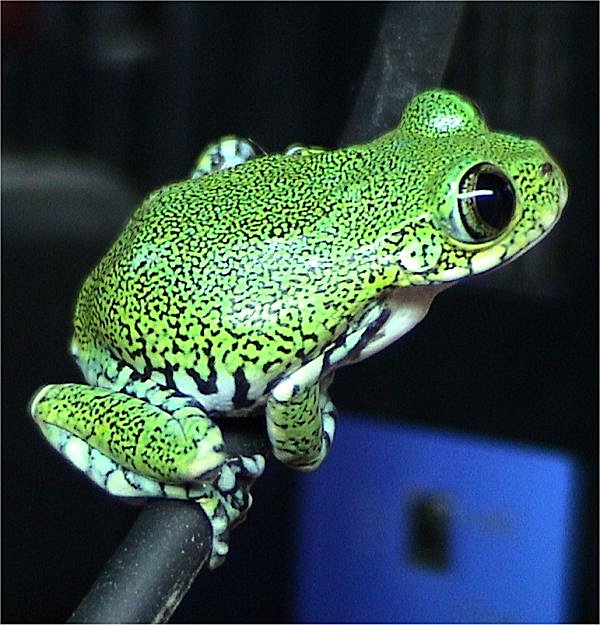- Big-eyed Tree Frog
:"The name "Big-eyed Tree Frog" is also used for "
Litoria exophthalmia " fromNew Guinea ."Taxobox
name = Big-eyed Tree Frog
status = VU | status_system = IUCN3.1
trend = down

regnum =Animal ia
phylum =Chordata
subphylum =Vertebrata
classis =Amphibia
superordo =Batrachia
ordo =Anura
familia =Hyperoliidae
genus = "Leptopelis "
species = "L. vermiculatus "
binomial = "Leptopelis vermiculatus"
binomial_authority =Boulenger , 1909
synonyms = "Hylambates vermiculatus"
"Leptopelis signifer"The Big-eyed Tree Frog ("Leptopelis vermiculatus") is a
species offrog found inforest areas in theAfrica n country ofTanzania . In some literature it is referred to as the Amani Forest Tree Frog.Physical description
This species is a medium to large frog ranging from 40-85 mm in length. It has two very different colour phases. In one phase they are a bright
green with scatteredblack specks all over the dorsal surface and the sides are marble with black andwhite . With some specimens the end of thetibia to the toes, forearms and upper lip have white blotching outlined with dark green or black. In the other phase they arebrown with an irregular shaped, darker brown triangular patch on the dorsum. Randomly placed darker or lighter brown spots and patches may appear over the dorsal surface, legs and forearms and a dark brown streak often runs from behind the tympanum ending halfway between thearmpit andgroin . In both phases the ventral surface is cream-white. Some specimens show a transition between both phases and change from the green phase to the brown phase as they mature. Theeye s are very big compared with body size and are golden with brown lines and flecks. It has large toe pads that are used for climbing. The tympanum is distinct.Ecology & behaviour
This species inhabits the closed-canopy wet tropical
rainforest s of Tanzania between the altitudes of 900 and 1800 m. Males call while in the water, and are very territorial. They have two different calls: one is a “ga…ga…ga”, used for attracting females, and the other is a “rrrrrrrr-ga” used for deterring other males of the same species. They are insectivorous.imilar species
This species is very similar to the Yellow-spotted Tree Frog ("Leptopelis flavomaculatus"), a species that also varies greatly in dorsal patterning and colouration. The Yellow-spotted Tree Frog, in its green phase, lacks the fine black specks that are present over the dorsum in the Big-eyed Tree Frogs green phase. The brown phase of the Yellow-spotted Tree Frog has a white blotch on the elbow, which brown phase Big-eyed Tree Frog lack.
References
* Database entry includes a range map, a brief justification of why this species is vulnerable, and the criteria used
* [http://www.amphibiaweb.org/cgi/amphib_query?query_src=aw_lists_genera_&where-genus=Leptopelis&where-species=vermiculatus#818 AmphibiaWeb - "Leptopelis vermiculatus"]
* [http://www.globalamphibians.org/servlet/GAA?searchName=Leptopelis+vermiculatus Global Amphibiam Assessment - "Leptopelis vermiculatus"]
* [http://research.amnh.org/herpetology/amphibia/references.php?id=8080 Amphibian Species of the World: "Leptopelis vermiculatus"]
Wikimedia Foundation. 2010.
